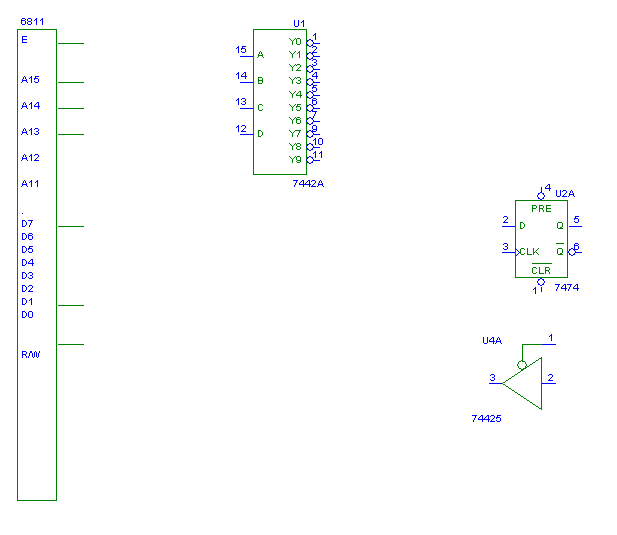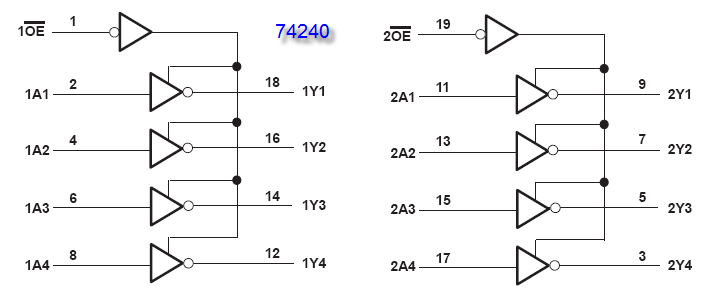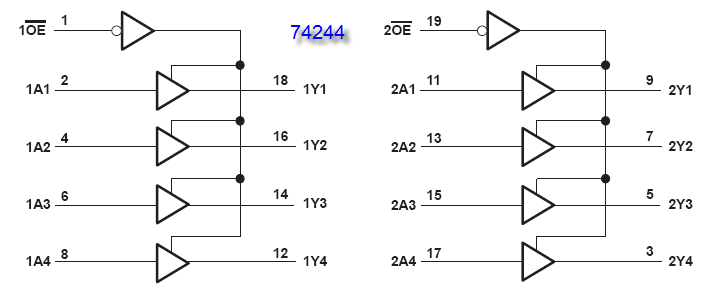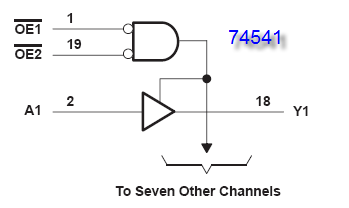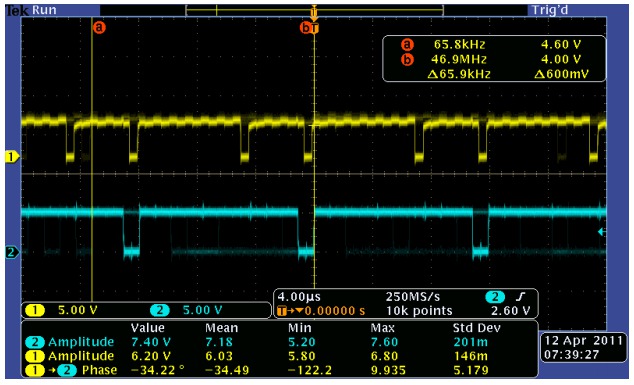Difference between revisions of "CSC270 Lab 10 2012"
(→Step 7: More Programming) |
(→Step 1: Basic Design) |
||
| (4 intermediate revisions by the same user not shown) | |||
| Line 17: | Line 17: | ||
<CENTER> | <CENTER> | ||
| − | [[Image: | + | [[Image:6811_input_incomplete2.png | 500 px]] |
</CENTER> | </CENTER> | ||
Connect the E and address bits to the decoder the exact same way you did in the last Lab, so | Connect the E and address bits to the decoder the exact same way you did in the last Lab, so | ||
| Line 44: | Line 44: | ||
===Step 3: Programming=== | ===Step 3: Programming=== | ||
| − | * Write an endless loop that will constantly read a byte (your interested in 1 bit, but you have to get a whole byte none-the-less) at the address | + | * Write an endless loop that will constantly read a byte (your interested in 1 bit, but you have to get a whole byte none-the-less) at the address corresponding to your 1-bit input port, and write it back at the same address, storing it in the 1-bit flipflop. |
| − | corresponding to your 1-bit input port, and write it back at the same | ||
| − | address, storing it in the 1-bit flipflop. | ||
* Assemble the program, and enter it in your kit. | * Assemble the program, and enter it in your kit. | ||
| Line 52: | Line 50: | ||
* Run the program. | * Run the program. | ||
| − | * Use the scope and verify that the Yi output of the decoder that you are | + | * Use the scope and verify that the Yi output of the decoder that you are currently using for your 1-bit flipflop is energized by your program. |
| − | currently using for your 1-bit flipflop is energized by your program. | ||
:It should look something like this: | :It should look something like this: | ||
<CENTER> | <CENTER> | ||
| Line 60: | Line 57: | ||
</CENTER> | </CENTER> | ||
| − | * Monitor the R/W signal as well, and watch both the Yi output and R/W'. | + | * Monitor the R/W signal as well, and watch both the Yi output and R/W'. You should observe something similar (though not exactly equal) to the following picture (taken by Tiffany Liu, 2011): |
| − | You should observe something similar (though not exactly equal) to the | ||
| − | following picture (taken by Tiffany Liu, 2011): | ||
<CENTER> | <CENTER> | ||
| Line 68: | Line 63: | ||
</CENTER> | </CENTER> | ||
| − | Explain why you see a R/W | + | Explain why you see a R/W pulse only every other Yi pulse. Make sure you indicate which signal is which on your scope captures! |
| − | pulse only every other Yi pulse. Make sure you indicate | ||
| − | which signal is which on your scope captures! | ||
<!--center> | <!--center> | ||
| Line 81: | Line 74: | ||
'''Do NOT connect the output of the driver to D0 yet!''' | '''Do NOT connect the output of the driver to D0 yet!''' | ||
| − | *Connect the enable input(s) of your driver to the oscilloscope and | + | *Connect the enable input(s) of your driver to the oscilloscope and observe it/them along with R/W and your Yi signal (use 3 probes). |
| − | observe it/them along with R/W and your Yi signal (use 3 probes). | ||
| − | |||
| − | |||
| − | |||
| − | |||
| − | |||
| − | |||
| + | * Verify that your driver is turned ON '''only when R/W is high and Yi is low'''. You shouldn't connect the data output of your driver to the data bus (bit D0) until you are sure that the gate is activated at the correct time, under correct conditions. Failure to do this will result in the destruction of some chips (either the ones on your breadboard, or the ones inside the kit), ''so, please, be careful!'' | ||
===Step 5: Connection to Data-Bus=== | ===Step 5: Connection to Data-Bus=== | ||
| − | * Once you have observed and verified the correct timing of the signals, connect the output of | + | * Once you have observed and verified the correct timing of the signals, connect the output of the driver to D0, and its input to one of the switches. |
| − | the driver to D0, and its input to one of the switches. | ||
| − | * Activate the switch (you might want to use a tiny screwdriver), and verify that | + | * Activate the switch (you might want to use a tiny screwdriver), and verify that the LED turns ON or OFF according to the position of the switch, as we should expect. |
| − | the LED turns ON or OFF according to the position of the switch, as we should | ||
| − | expect. | ||
===Step 6: Understanding Address Decoding=== | ===Step 6: Understanding Address Decoding=== | ||
| Line 106: | Line 90: | ||
===Step 7: More Programming=== | ===Step 7: More Programming=== | ||
| − | * Write a program that makes the LED blink (choose whatever blinking frequency you wish) when the switch is in one position, | + | * Write a program that makes the LED blink (choose whatever blinking frequency you wish) when the switch is in one position, and that turns the LED OFF when the switch is in the opposite position. (similar to the last homework assignment, but here you do not have to make the LED oscillate at 500 MHz!) |
| − | and that turns the LED OFF when the switch is in the opposite position. (similar to the last homework assignment, but here | ||
* Again, demonstrate the correct operation of your program, please! | * Again, demonstrate the correct operation of your program, please! | ||
Latest revision as of 07:32, 17 April 2012
--D. Thiebaut 08:19, 17 April 2012 (EDT)
Contents
Designing a 1-bit input I/O controller
Today you have a simple design to implement, but you should make sure you go through the steps carefully, as a flaw in the design could kill some of the kit's components.
This lab assumes that you have assembled, designed and fully tested the 1-bit output controller from Lab #9.
Step 1: Basic Design
Complete the address decoding part of the schematics below, using the approach we took last lab and this week.
Connect the E and address bits to the decoder the exact same way you did in the last Lab, so that you will not have to change the wiring on your kit.
What hexadecimal address did you assign to your flipflop in Lab 10?____________
What Yi output is activated by this address? _________
This is the same address we will use for your 1-bit input. We can use the same address for both ports, the input port and the output port, because in the new design the output port (flipflop) is energized only when R/W is low (the processor writes the bit to the flipflop), and the input port you are building tonight will be energized only when R/W is high (the processor will read the bit generated by the switch).
Draw the timing diagrams for a STAA XXXX and a LDAA XXXX instruction, where XXXX is the address you picked for the I/O port. Make sure you show E, the Address bus, R/W, D0, the clock input of the flipflop, and the active-low enable of the tri-state driver.
Step 2: Wiring
Wire up your kit so that it matches your design. HOWEVER, DO NOT CONNECT THE OUTPUT OF THE TRI-STATE DRIVER TO DATA BIT D0. We will do this only when we are sure your circuit is wired correctly. You have several tri-state drivers available to you to choose from:
Pick the one that works best for your design.
Step 3: Programming
- Write an endless loop that will constantly read a byte (your interested in 1 bit, but you have to get a whole byte none-the-less) at the address corresponding to your 1-bit input port, and write it back at the same address, storing it in the 1-bit flipflop.
- Assemble the program, and enter it in your kit.
- Run the program.
- Use the scope and verify that the Yi output of the decoder that you are currently using for your 1-bit flipflop is energized by your program.
- It should look something like this:
- Monitor the R/W signal as well, and watch both the Yi output and R/W'. You should observe something similar (though not exactly equal) to the following picture (taken by Tiffany Liu, 2011):
Explain why you see a R/W pulse only every other Yi pulse. Make sure you indicate which signal is which on your scope captures!
Step 4: First-Phase Testing
Do NOT connect the output of the driver to D0 yet!
- Connect the enable input(s) of your driver to the oscilloscope and observe it/them along with R/W and your Yi signal (use 3 probes).
- Verify that your driver is turned ON only when R/W is high and Yi is low. You shouldn't connect the data output of your driver to the data bus (bit D0) until you are sure that the gate is activated at the correct time, under correct conditions. Failure to do this will result in the destruction of some chips (either the ones on your breadboard, or the ones inside the kit), so, please, be careful!
Step 5: Connection to Data-Bus
- Once you have observed and verified the correct timing of the signals, connect the output of the driver to D0, and its input to one of the switches.
- Activate the switch (you might want to use a tiny screwdriver), and verify that the LED turns ON or OFF according to the position of the switch, as we should expect.
Step 6: Understanding Address Decoding
- Modify your program and change only the address of the I/O Port to a different Hex value, and demonstrate that your setup still continues to work, even though you are now using LDAA and STAA instructions with a different address for the I/O port.
Step 7: More Programming
- Write a program that makes the LED blink (choose whatever blinking frequency you wish) when the switch is in one position, and that turns the LED OFF when the switch is in the opposite position. (similar to the last homework assignment, but here you do not have to make the LED oscillate at 500 MHz!)
- Again, demonstrate the correct operation of your program, please!
Graph Paper

